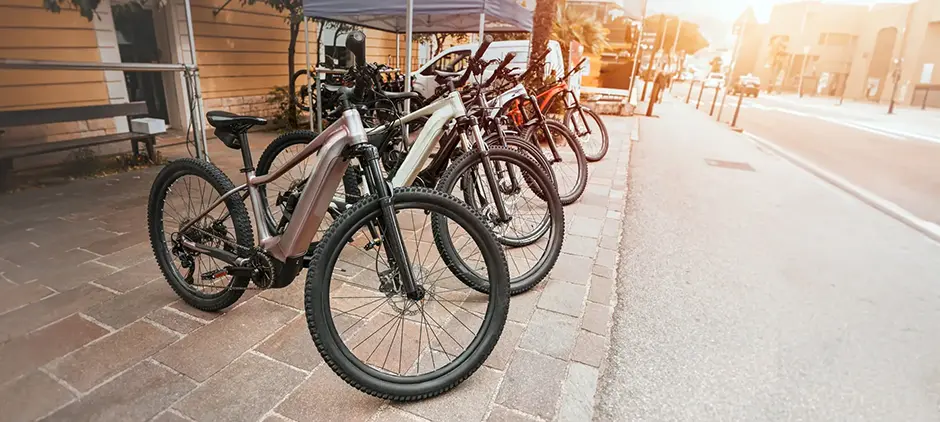With high speeds, small sizes, and affordable prices, e-scooters and e-bikes have become an appealing solution for commuters rushing to work in busy traffic. Unfortunately, they’ve also become a hazard, posing a threat not only to riders but also to other people on the road.
Also known as micromobility devices, electric bikes and scooters are growing in popularity, but many people don’t realize the risks involved in riding them. Accidents can result in injuries ranging from minor scrapes and bruises to life-changing head trauma, and the chances of getting injured by an e-scooter or bike increase every year.
Learn how common e-bike and e-scooter injuries have become and who might be responsible when filing a legal claim after an accident.
Are E-Scooter and E-Bike Injuries Soaring?
Injuries related to e-scooters and e-bikes have exploded over the past several years, particularly in urban areas. A report from the U.S. Consumer Product Safety Commission (CPSC) revealed that injuries associated with micromobility devices increased by almost 21% from 2021 to 2022. According to the report, these types of injuries are increasing by an estimated 23% each year.
A similar study by the University of California, San Francisco found that e-bike injuries doubled every year from 2017 to 2022 and e-scooter injuries increased by 45%. Researchers also found that helmet use was much lower among riders of electric bikes and scooters, which contributes to higher injury and fatality rates.
Although they have slightly different results, both studies underscore the same point: e-scooter and e-bike injuries are happening more often.
Why Have Injuries Increased?
E-bikes and e-scooters have become much more popular over the past decade, especially since cities began implementing sharing systems in 2017. They’re a compelling option for commuters because they cost so much less than most other forms of transportation, like rideshares and taxis. They’re also convenient, with the user simply reserving a device using an app, picking it up, and heading to work. These benefits of e-bikes and e-scooters make them enticing for people in cities where parking is limited and expensive, and cities across the nation have responded by implementing bike- and scooter-sharing systems.
According to the Department of Transportation, 49 cities have dockless bikeshare systems, and 130 have e-scooter systems. Because of this wide availability, more of these devices are in use today than at any other point in the past. More devices on the road naturally translates to a greater risk of injuries and accidents.
What Types of Injuries Occur in E-Bike and E-Scooter Accidents?
Victims of e-scooter and e-bike accidents experience many of the same injuries as people riding non-electric devices, but they’re often more severe because of the accelerated speed. The most frequent injuries that victims suffer include:
- Bruises, abrasions, and cuts
- Road rash
- Broken bones, particularly in the legs and arms
- Skull fractures
- Concussions
- Internal organ injuries
- Spinal injuries
- Traumatic brain injuries
In the worst cases, e-scooter and e-bike accidents can be fatal, particularly if the rider isn’t wearing a helmet.
What Makes E-Bikes and E-Scooters Dangerous?
A recent review of more than 3,000 e-scooter injuries found that nearly 80% were due to rider falls, but those falls aren’t always the result of the rider’s clumsiness. Several factors make e-scooters and e-bikes dangerous to riders and other people on the road.
Road Conditions
Poor road maintenance and weather hazards contribute to many e-bike and e-scooter injuries. Potholes, uneven surfaces, and slick surfaces can make it difficult for a rider to stay in control of the device, causing them to collide with vehicles or pedestrians. In addition, most cities don’t have designated lanes for micromobility devices. As a result, many riders weave across lanes and onto sidewalks, creating a chaotic and dangerous situation.
Device Design
By design, e-bikes and e-scooters are quiet and fast. While both of those characteristics create a more enjoyable riding experience, they also introduce new risks. Because e-bike and scooter motors make very little noise, pedestrians and other drivers may not realize that a rider is nearby on the roadway or sidewalk. Combine that fact with the speeds that these devices can reach — around 15 miles per hour for most e-scooters and faster for e-bikes — and the result is a perfect recipe for accidents and injuries.
Poor Maintenance and Manufacturing
Flaws in design, manufacturing, or maintenance processes are also a major factor in many accidents. Mechanical errors and brake malfunctions can cause scooters and bikes to go off course, move too fast, or fail to stop. Most of these devices also use lithium-ion batteries. When they aren’t properly maintained or get damaged, these batteries may start fires that can severely injure riders.
Rider Error
Many e-bike and e-scooter accidents are ultimately the result of the rider’s behavior or choices. For example, some drivers get distracted or fail to pay attention while riding their e-scooters or bikes. Others are unable to hear oncoming traffic, car horns, and pedestrians because they’re wearing earbuds and listening to loud music. As with cars, using alcohol or other substances while operating an e-bike or e-scooter also makes accidents much more likely.
Another issue at play is that most states and cities don’t require riders to complete any type of training before operating an e-scooter or e-bike. As a result, the rider may not realize how to safely operate the device, what to do if there’s a mechanical issue, or how to react to sudden hazards on the road.
Unfortunately, many of the people who rely on e-bikes and e-scooters for their daily commutes also aren’t following standard safety recommendations, such as wearing helmets and padding. A lack of consistent legislation requiring this kind of equipment contributes to the problem. For example, while Louisiana state law requires riders on e-bikes to wear approved bicycle helmets, many states have helmet laws that don’t apply to micromobility devices.
Who Is Liable in an E-Scooter or E-Bike Claim?
Victims in e-scooter and e-bike injury cases can often seek damages for their medical expenses, pain and suffering, and lost wages. To file a successful claim, victims have to begin by determining who was responsible for the accident.
Demonstrating Negligence
Many e-bike and e-scooter accidents are the result of one or more parties being negligent. Demonstrating negligence involves establishing four key factors:
- Duty of care: The first step is to show that the at-fault individual owed the victim a duty of care, including following traffic laws to protect pedestrians and other people on the road.
- Breach of duty: Next, the victim has to prove that the responsible party violated their duty of care by acting in a reckless or unsafe manner, such as speeding or texting while driving.
- Causation: The victim also has to show that their injuries occurred because of the responsible party’s breach of duty.
- Damages: Finally, the victim needs to demonstrate that they’ve experienced damages, such as spending money on hospital bills or property repairs, as a result of the accident and their injuries.
All four of these elements have to be present to hold someone responsible in an e-bike or e-scooter injury claim.
Potential At-Fault Parties
When an e-scooter or e-bike accident occurs, someone is often to blame, but it can be difficult to determine exactly who that person is. These are some of the parties that might be at fault:
- Manufacturers: Some e-bike and e-scooter cases fall under product liability laws. For example, if the manufacturer produced a scooter with faulty brakes that caused or contributed to an accident, the victim could hold them responsible for creating a defective product that led to their injuries.
- Rental companies: Companies that rent e-scooters and bikes to the public have a responsibility to perform regular inspections and maintenance. If they fail to do so and the device malfunctions or fails, the victim can usually hold them responsible for their negligence.
- Municipalities: If the city government doesn’t properly maintain the roads, it might also be at fault for an e-scooter or e-bike claim. For instance, a municipality might have some degree of responsibility if it doesn’t repair road damage that causes a rider to fall or crash their device.
- Other drivers and riders: Drivers of cars and other micromobility devices may also be to blame for an accident. For instance, if someone is driving while under the influence and hits an e-scooter or a pedestrian, they’re generally liable for any physical and emotional damage the victim experiences.
In some cases, more than one person or party is responsible for an accident. For instance, if the rider was distracted by their phone and also hit a large pothole in the road, both the rider and the municipality tasked with road maintenance might be at fault. When multiple parties share responsibility, it can affect the amount of damages the victim can seek and whom they include in their claim.





